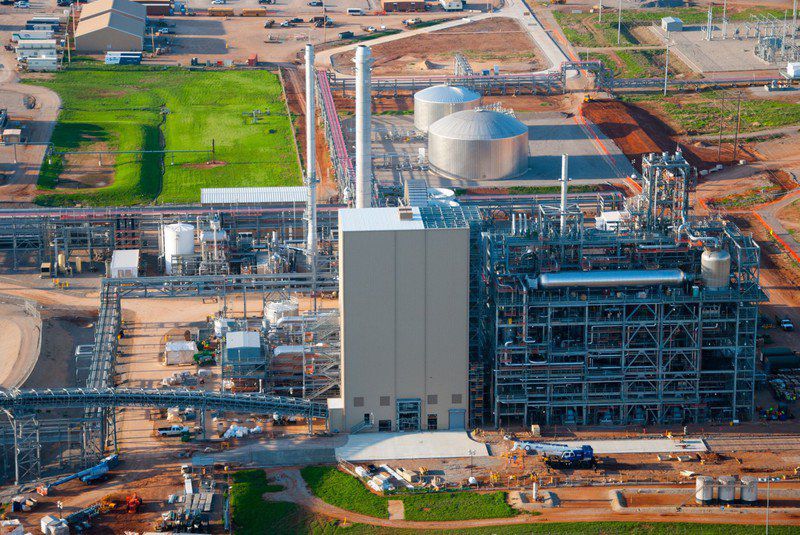A $1.3 billion expansion at the Koch Fertilizer plant is nearing completion.
Components of the expansion include a new 900,000 ton-per-year urea plant, high-speed truck and rail loading facilities, additional urea storage capacity and an electric power substation.
“We’ve also added capability to produce high-purity urea to serve the diesel exhaust fluid (DEF) market, which is a new product for Enid,” Director of Business Communications Rob Carlton said. “Additionally, we’re very excited about two other phases of the expansion project. We will soon be producing SUPERU Fertilizer, an enhanced efficiency fertilizer from Koch Agronomic Services that protects against all three forms of nitrogen loss. We’ve also added infrastructure to process tertiary water discharged from the city’s wastewater treatment plant.”
The objective of the expansion was to increase the plant’s efficiency, boost production capacity and add new products to the mix, with the addition of both DEF and SUPERU Fertilizer, he said.
With the infrastructure to process tertiary water, or “gray water,” the plant can cut down on its use of potable water — the clean water provided to Enid residents.
Prior to the expansion, the plant used an average of 4 million gallons of water per day. When the expansion is complete, usage will be closer to 6 million gallons.
“However, the water treatment technology we’ve installed from Koch Membrane Systems enables us to treat and use tertiary water from the city in place of potable water. Our long-term goal is to reduce our potable water demand to less than 1 million gallons per day,” Carlton said. “In effect, we’re decreasing our historic demand on the city’s potable water resources by up to 75 percent, while substantially increasing our overall fertilizer production capacity.”
The tertiary water is used as a cooling medium, and for producing steam to drive machinery.
Supplied through an offtake agreement with the city of Enid, the tertiary water eventually will be fed into the plant’s wastewater treatment facility.
“That facility has the capacity to treat up to 8 million gallons per day of tertiary water, making it the largest industrial re-use project in Oklahoma’s history. The water is then reused multiple times throughout the production process before being safely and responsibly discharged,” he said.
Carlton said the city of Enid has been a “very forward-thinking” partner in the project.
“By supplying the plant with tertiary water, we are able to reduce our demand on potable water, which frees up those valuable resources. That creates an attractive environment for the city to pursue other industrial business opportunities,” he said.
There currently are 268 employees at the Enid plant, and 32 open positions. When the plant is fully staffed, about 120 roles will have been added with the expansion, Carlton said.
The majority of construction and commissioning activities are expected to wrap up by the end of the year, he said. Ground was broken on the expansion in October 2014.
At the height of construction, there were around 2,800 contractors on site, he said.
“Which was a huge boom to our local economy,” Enid Regional Development Alliance Executive Director Brent Kisling said.
ERDA has been pleased to work with Koch over the past three years during the construction, he said. It has had an impact with depressed oil prices.
“Most of the major construction is completed and they’re doing testing on the equipment,” Kisling said. “It’s very impressive. It is a massive facility that’s going to be a great asset for us in Enid for a very long time.”
Kisling has called it the largest capital expenditure for business expansion in state history.
“This is almost the equivalent of two Devon Towers being built on the east side of Enid, just to put it in perspective,” he said.
When Koch Fertilizer started the expansion, it was one of North America’s largest fertilizer plants. They make ammonia fertilizer and urea fertilizer, Kisling said.
“Through this expansion, they are almost doubling the size of their output, out at that facility,” he said.
Another aspect of interest, that has not really been discussed, is Koch will do larger and more frequent “turnarounds” with the expanded capacity, Kisling said. These consist of shutting down the plant and doing cleanings and repairs, during which several hundred people will be in Enid.
“That’s an economic impact that we really haven’t figured in this project,” he said.
ERDA works closely with plant leadership to know when those turnarounds are going to take place and tries to manage the Enid event schedule accordingly, as it may be difficult to bring a convention into town at the same time, Kisling said.
Story provided by: Enid News & Eagle
Written by: Jessica Miller


